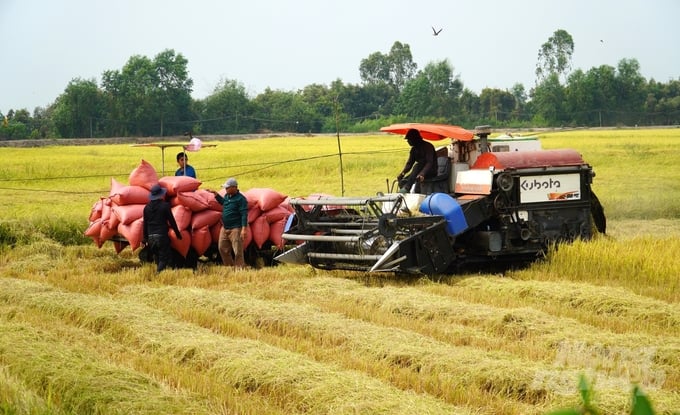November 27, 2025 | 10:52 GMT +7
November 27, 2025 | 10:52 GMT +7
Hotline: 0913.378.918
November 27, 2025 | 10:52 GMT +7
Hotline: 0913.378.918

The main causes of increased greenhouse gas emissions in our country's rice production are unsustainable agricultural intensification, high fertilization rates, and water use for irrigation. Photo: Kim Anh.
According to the Food and Agriculture Organization of the United Nations (FAO) and according to research by the World Bank (WB) in Vietnam, agriculture is the second highest "contributing" sector to greenhouse gas emissions in Vietnam, with about 19% of total emissions in 2020, estimated at 104.5 million tons of carbon dioxide equivalent (abbreviated tCO2e). To make it easier, let's imagine that in a year when Vietnam emits 5 tons of CO2, agriculture contributes 1 ton, showing how much greenhouse gas emissions agriculture causes.
In agriculture, rice production accounts for 48% of emissions, followed by livestock (15.3%), fertilization (12.9%), green manure management (9.5%) and other activities. A unique feature of agricultural emissions is that more than 70% are methane and nitrous oxide.
FAO estimates that carbon emissions from rice production were estimated at 44 million tCO2e in 2020, and the more farmers increase rice production, the more emissions increase.
The World Bank believes each ton of rice produced in China and India emits methane equivalent to 0.7 tons of CO2. Vietnam's methane emissions are higher than those of China and India, estimated at 0.9 tons of CO2.
To sell carbon credits from growing rice, farmers must also not burn straw, increasing the amount of biofertilizer, aiming to reduce methane emissions and create low carbon from rice cultivation. In particular, farmers must adequately follow the carbon credit assessment reporting process.
The more intensively farmers cultivate rice, the more carbon emissions they emit; Increased irrigation (3,000–5,000 liters of water per kg of rice) and increased nitrogen, phosphorus, and potassium fertilization (estimated at 400 kg per ha) are some of the reasons for the increased carbon intensity of rice production in Vietnam.
There are five main causes of increased greenhouse gas emissions in Vietnam's rice production: unsustainable intensive farming; excessive fertilization; Use of a lot of water for irrigation; Improper management of waste/by-products such as straw and rice husks; Inefficient use of energy in agriculture.
Simply put, rice growers chase productivity and output, so they sow thickly, sow many crops, use high land intensity, irrigate too much water, and fertilize too much to have high yields. For example, currently in Vietnam is said to be the country that uses NPK fertilizer the most in East Asia per hectare of land.
Even rice by-products such as rice straw are often improperly managed, typically burning rice straw in the field generating greenhouse gases of 0.7–4.51 g CH4 and 0.019–0.069 g N2Oper kg of burned straw, not to mention emissions from burning straw in the fields, also causes negative consequences for human health and the surrounding environment.
Growing rice to reduce emissions has been one of the major policies of the agricultural sector for many years, because wanting to reduce emissions essentially means reducing input production costs to increase farmers' income such as reducing fertilizers, pesticides, reducing irrigation water, utilizing straw...
However, it seems that the media and many people are "overly excited" when posting information and statements in the media about growing rice to sell carbon credits, and there is even more "exciting" information when said a commune in Dak Lak where farmers grew rice and sold carbon credits.
Mr. Dao Xuan Lai, Head of the Climate, Environment, and Energy Department of the United Nations Development Program in Vietnam, said that, in theory, rice growing in Vietnam can participate in selling carbon credits, but that is an act. The process is long, and growing rice on a small scale, fragmented, without unifying water - fertilizer - and seeds... like today, is impossible.
The long journey that Mr. Lai clearly said will not be easy in the next 5 or 10 years. It is large-scale rice production, with farmers linked together on an area of tens or hundreds of thousands of hectares, with a production process from input plowing and sowing to output of milling finished rice. Over time, it has been proven that reducing emissions and abandoning the mindset of increasing input costs to achieve high yields has been ingrained in farmers for decades.
As for the writer's research about rice farmers selling carbon credits in Dak Lak, it turns out that it is a very small model, only 4-5 hectares of rice, and what the company is doing with farmers is still just a test to measure whether the application of new production methods can reduce emissions or not.
Before dreaming of growing rice to sell carbon credits, farmers could grow rice to reduce emissions, which means increasing income by reducing costs, which is also very successful in agriculture.
Translated by Huong Giang

(VAN) As floodwaters recede, a vast network of irrigation works across eastern Gia Lai is emerging in a state of severe disrepair, with extensive damage demanding urgent restoration ahead of the 2025-2026 winter-spring cropping season.

(VAN) The conference reviewing three years of implementing Decision 911 identified the need to prioritize improving marine environmental quality and promoting sustainable fisheries development.

(VAN) Le Hoai Trung, Member of the Communist Party of Vietnam Central Committee and Minister of Foreign Affairs, held talks with Vi Thao, Chairman of the Guangxi Zhuang Autonomous Region (China) this week.

(VAN) The Mekong River Commission adopts the 2026 - 2030 Strategic Plan with a people-centered approach.
/2025/11/26/1720-1-200855_132.jpg)
(VAN) Viet Nam and Japan have many conditions to expand cooperation on climate change adaptation, particularly in disaster risk management based on advanced technologies.

(VAN) The strong development of digital technology and artificial intelligence is opening up opportunities to transform science and technology into a 'Magic eye' for disaster forecasting and early warning.

Applying vaccines and proactive disease prevention helps pig herds stay healthy, maintain productivity, reduce risks, and decrease reliance on antibiotics in modern livestock farming.